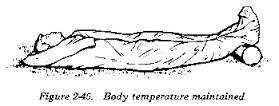In this episode we talk about a way to prevent drowning with a simple action plan, especially in water that is not clear and may be cold. Watch now to learn!
Tag Archives: hypothermia
4 Must Have Items For Winter Weather Preparedness
In this episode, I talk about how I almost headed out on the road without my back up winter weather gear. But then I thought better of it and practiced what I preach. I thought I’d make it into a RoyOnRescue episode and show that we all have to be disciplined to prepare and not get caught off guard. I hope it helps!
Does Eating Snow Cause Hypothermia?
A Rescue Fan wrote in and basically said, “Hey! Bad advice! Everyone knows that eating snow when stranded in the wilderness is a bad idea. It can make a person hypothermic!”
As I thought about their comment, I began to do some research and then some deeper thought on the subject.
I instantly began to wonder if the commenter had a point. Is it better to slow down the hypothermia that may be already causing symptoms or die from dehydration?
Remember, hypothermia usually sets in as quick as 3 hours or less in certain cases while life threatening dehydration can take up to 3 days. So, if you’re surviving the elements long enough to dehydrate, you’re probably staying somewhat warm. If so, then consuming snow or melted snow and getting hypothermic as a result is probably the last of your concerns when thinking about staying alive. For if you survive the elements, dehydration and death will be knocking in about 2-3 days.
http://www.livescience.com/32320-how-long-can-a-person-survive-without-water.html
Why Do We Cover A Patient In Shock?
Hello Rescue Fans!
In this unedited video, I talk about and explain why we cover a patient who may be showing signs of shock after this question came in by ema il. Remember, it’s important to help the patient feel comfortable, cared for, and safe as best as possible. But physiologically speaking…keeping the patient warm helps prevent hypothermia “which shifts the oxyhemoglobin dissociation curve to the left, impairs oxygen delivery, and exacerbates the shock state.”(http://www.ebmedicine.net/topics.php?paction=showTopicSeg&topic_id=110&seg_id=2113) And in the end, the fact that the person feels well cared for can help them become less anxious and do better through the traumatic event. Hope this helps.
il. Remember, it’s important to help the patient feel comfortable, cared for, and safe as best as possible. But physiologically speaking…keeping the patient warm helps prevent hypothermia “which shifts the oxyhemoglobin dissociation curve to the left, impairs oxygen delivery, and exacerbates the shock state.”(http://www.ebmedicine.net/topics.php?paction=showTopicSeg&topic_id=110&seg_id=2113) And in the end, the fact that the person feels well cared for can help them become less anxious and do better through the traumatic event. Hope this helps.
Could You Survive Stranded In A Snow Storm?
After hearing about a couple getting stranded in a mountain pass off-roading and the driver dying while seeking help, I thought I should talk about key elements around surviving out in the cold. People are often overcome by the cold simply due to lack of pre-planning, proper equipment and an adequate plan for survival until rescue help arrives. If you’ve ever wondered what you would do if you were lost, stranded or overcome by the winter elements, be sure to watch this episode of RoyOnRescue.
In the meantime, remember at least these important points:
1. Let people know where you are going and what route you’ll be taking…then stick to it!
2. Dress with layers of clothing or have extra clothing available
3. Bring warming agents like hand and pocket warmers along with extra blankets
4. Bring extra food that can handle getting cold or even freezing like granola, nuts etc.
5. Eat snow for hydration
6. Bring GPS
7. Bring Flare Gun
8. Never drive with low gas tank
9. If the roads are dangerous, maybe stay home or extend your vacation
10. Repeat steps 1 thru 9
Peace,
Roy, RoyOnRescue.com
Shock and the Capillary Refill Test
In this RoyOnRescue Video Blog, a student had emailed Roy a question about explaining the Capillary Refill Test and how it may relate to determining if someone is suffering from shock.
Be sure to watch this episode of RoyOnRescue and learn a new trick that could either tell you if someone is going into shock, or that their hands are simply cold.
There are three main reasons why a person may have more than a 2 second capillary refill time:
1. Shock
2. Peripheral Vascular Disease
3. Hypothermia or cold hands
This slow capillary refill time of more than 2 seconds should only be an indication that we should check for other problems. Please don’t assume simply because someone has a slow cap. refill that they are going into shock. It is simply a quick and easy test to help point a first aider in the right direction and to tell us we should check for other issues.

